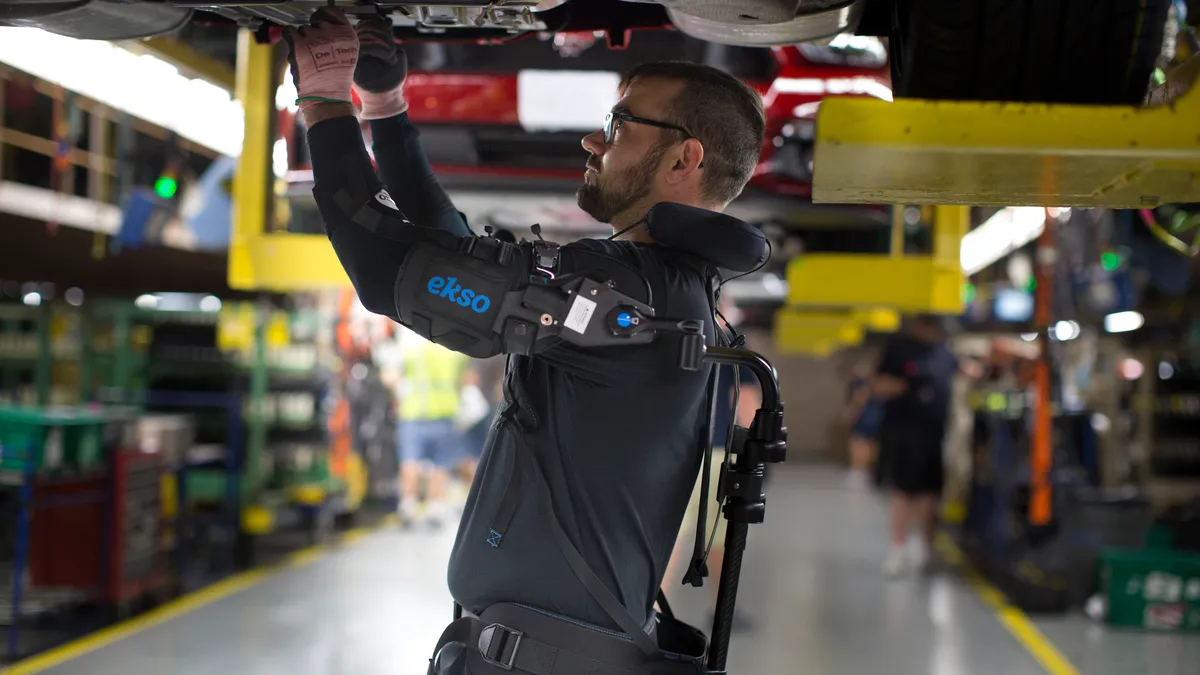Construction Dive’s new series, Tech 101, provides quick, top-line information about emerging construction technology. Click here for the latest article in the series. What type of tools would you like a primer on? Email [email protected].
Sometimes referred to as exosuits, exoskeletons are a type of wearable technology that helps lessen worker strain from repetitive tasks that are common in manufacturing and construction. By providing support and reducing stress on the user's body, these machines that attach to the human body enhance the ability to work quickly and safely and help reduce injuries.
Although only offered by a handful of manufacturers like Ekso Bionics, Levitate Technologies and Sarcos Robotics, exoskeletons are in use by a number of major U.S. companies including Toyota, Boeing and GM and they are slowly making their way onto commercial construction sites. (Click here for a roundup of exoskeleton products available in the U.S.)
What you should know
An exoskeleton contains a frame that goes around all or part of a user’s body. The frame can be made out of a hard material such as metal or soft materials, such as special kinds of fabric, according to manufacturer Levitate.
Apart from being protective and performance-enhancing due to their mechanical attributes, some exoskeletons incorporate sensors that can monitor and respond to users’ movements.
The wearable technology comes in two main types: powered and passive (also known as mechanical). While industry watchers first predicted that large full-body powered suits would quickly take over manufacturing and construction, in recent years the emphasis has switched to smaller, specialized exoskeletons, according to the Exoskeleton Report. These smaller units, generally operated by pulleys or springs, fall into the following categories:
- tool-holding arms
- back support vests
- powered gloves
- chairless chairs, which are flexible, wearable seats
- supernumerary units that provide an extra pair of robotic hands
A benefit of the passive versions is that they don't have cords or need to be recharged, said Jack Moran, VDC manager at Consigli, which employs several mechanical units from Ekso.
"We wanted to give our workers the freedom to move around without a cord attached," he said.
While the main draw for the wearables is to lessen worker fatigue and improve productivity, Moran told Construction Dive they can also improve quality of work.
"If you're working overhead and not having to struggle with a heavy tool and the fatigue that comes with it, [exoskeletons impart] a positive impact on the quality of your work," he said.
Construction Applications
Wearables have major implications for the construction industry because they have the ability to make laborers more effective and can keep those dealing with old injuries or age-related issues on the job longer.
The units have been in use since last June at Consigli, which has a large self-perform group. The Milford, Massachusetts-based contractor has one passive EksoVest upper body exoskeleton that provides up to 15 pounds of lift-assist per arm for overhead work like drilling, chipping or installing insulation, Moran said.
“As you can imagine over time, you start to feel that fatigue in your shoulders," he said, "so this helps with that a lot."
The cost for the model Consigli purchased, which is adjustable to different users, was about $7,000, Moran said, adding that he believes units that are nonadjustable and only for a specific task and specific user are closer to $4,000. Construction Dive was not able to verify costs of specific models, though in any sense, as evidenced with other types of novel construction tools such as drones, prices will likely come down once the technology becomes more commonplace in the market.
The company also uses EksoZeroG arms for work on platforms and scaffolding. It has been a big help for workers attaching metal panels in a parking garage project in Portland, Maine, and chipping brick on a historic remodel in Boston.
"Our guy was using a 36-pound hammerdrill with one hand while he was spraying down the wall with the other," Moran said. "It really improves efficiency by not having to stop and rest your arms or rotate crews out as frequently."
Roadblocks
While exoskeletons aren't inexpensive, costs have already come down in recent years, and those who use them say they pay for themselves with more productive jobsites and fewer injuries. While the first vest Consigli purchased was $7,000, the second one was $5,000, Moran said.
"In the whole context of things, it's pretty affordable compared to the cost of a shoulder injury," he said.
Besides cost, another issue holding back wide-scale adoption is a lack of common standards, according to Forbes contributor Borislav Marinov, founder of the Exoskeleton Report. With no guidelines, common terminology or testing methodology, users are left to develop their own best practices and evaluation procedures. The disconnect, Marinov wrote, is preventing the gathering of test results, which, in turn, has hindered the development of industrial exoskeleton applications.
For more reading
We have the technology ... why not wear it?
Lack Of Exoskeleton Standards Is Holding Back Their Adoption In The Workplace
How Exoskeletons Are Changing Construction
Exoskeletons and Injury Prevention





















